As the promise of Artificial Intelligence (AI) within corporate performance management (CPM) moves from fiction to fact, many FP&A teams are asking the same basic question. What do AI and Machine Learning (ML) mean for me?
To answer this question and more, our AI for FP&A blog series is designed to help organizations prepare for the AI and ML journey and move beyond the hype. Where to begin? Well before jumping into any new journey, it’s critical to chart the course to anticipate what’s in store on the road ahead. And for a topic as exciting and overhyped as AI, any new journey must begin by considering the key factors that have traditionally held Finance back from AI adoption.
Market Appetite for AI and ML
As we shared in the first post of the AI for FP&A blog series, about 60% of organizations are using or actively exploring ML according to the 2021 Dresner Advisory Wisdom of Crowds® Data Science and Machine Learning Market Study (see Figure 1). On the surface, the progression over the last 5 years underscores the AI hype and excitement for the potential of AI for FP&A.
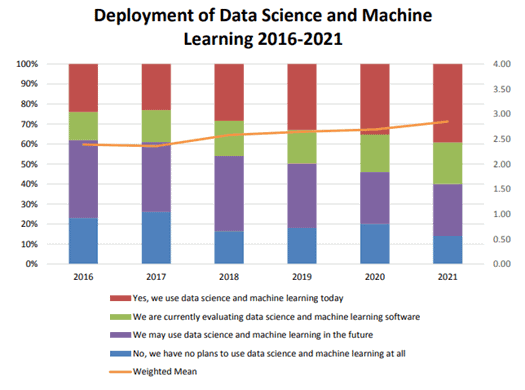
But when one breaks the data down by function, a bit of a different reality emerges for the Office of Finance and FP&A.
The study shows that only 20% (see figure 2) of Finance organizations are currently using AI and ML, and Finance actuals lag most functions despite all the buzz and chatter we all hear about.
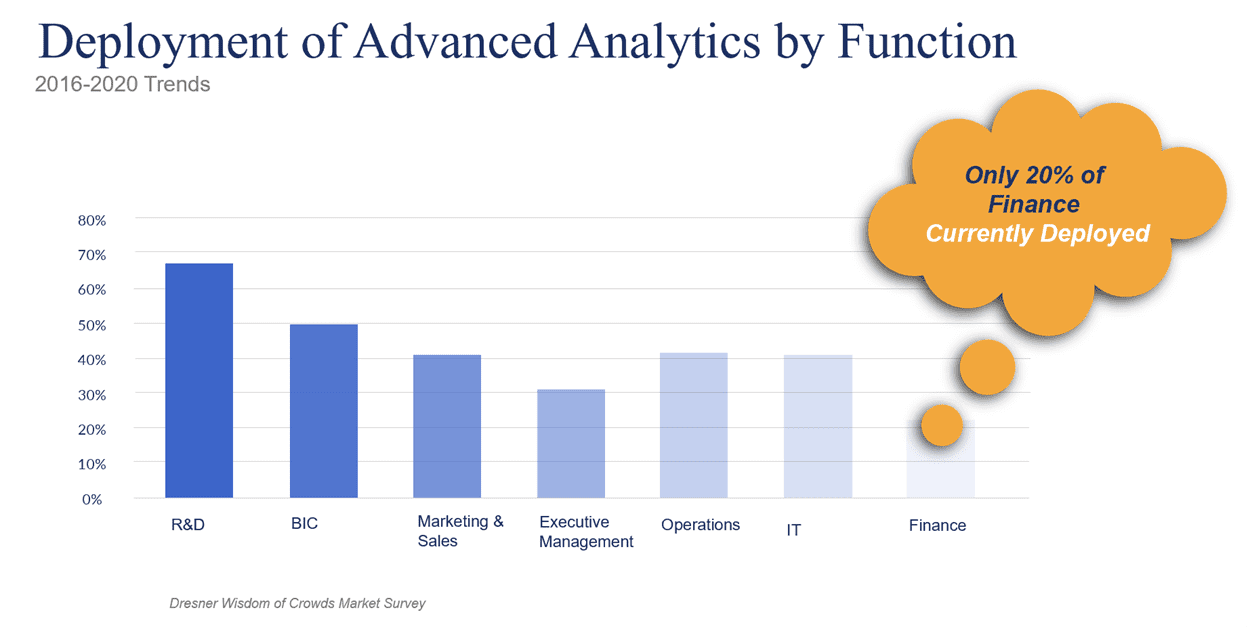
What’s Holding FP&A Back?
With so much buzz and such little adoption, let’s examine the key barriers holding FP&A and Operations teams back from mainstream adoption of AI and ML solutions (see figure 3):
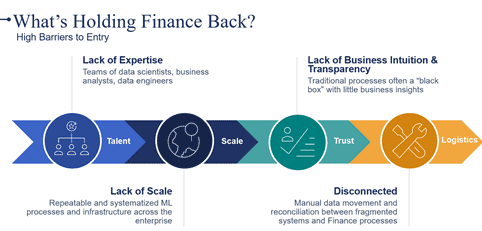
Lack of Expertise
- If FP&A teams believe that they themselves are required to learn AI and machine learning modeling techniques, chances are FP&A teams will have trouble deploying AI across enterprise planning processes. This includes processes such a rolling forecasting or demand planning where there could be hundreds or thousands of unique forecasts. Further, for organizations with existing AI investments, FP&A teams generally lack dedicated business analysts and data science engineers required to build ML models.
Without dedicated expertise or resources, FP&A’s ability to take advantage of AI and ML is severely limited.
Lack of Scale
- For organizations with existing data science teams, creating repeatable and systematized ML processes and infrastructure across the enterprise is expensive. Additionally, most ML capabilities within CPM tools today are only capable of producing a single forecast (target) at a time. Why does that matter?
- It’s FP&A’s role to lead and drive effective planning processes across lines of business and functions such as HR, Sales, and Operations. And if FP&A cannot enable the organization to forecast at scale, FP&A is not executing as a strategic business partner. AI solutions for FP&A that cannot scale are no different and will never reach mass adoption and fail.
Lack of Business Intuition & Transparency
- Traditional ML modeling processes within CPM tools are often a “black box” to FP&A teams (See Figure 4). Why does this matter? If ML modes are completed without material business “intuition” and/or offer users only limited visibility or traceability into model inputs and results. Such limitations can result in a lack of trust or confidence in the results.
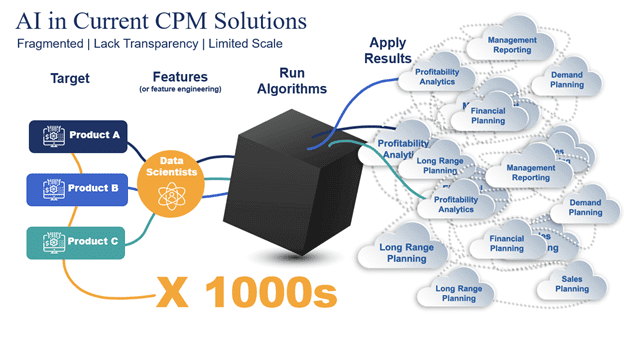
As a strategic business partner, it’s FP&A’s role to instill confidence in forecasting processes. And while leveraging AI and ML is likely to increase forecast accuracy – if P&L owners cannot assess the drivers that comprise their forecasts – P&L leaders will never own their forecasts.
And if P&L owners do not own their forecasts, forecasting processes break down and fail altogether which means FP&A has failed too.
Fragmented & Disconnected Processes
- Current AI and ML solutions within CPM typically require data movement and reconciliation between fragmented systems and Finance processes, increasing the technical debt and limiting the ability for advanced analytics to scale across the organization.
- The fragmented software and technical processes needed for connected planning create added technical complexity and administrative burden for FP&A teams. This burden includes constantly moving and reconciling data, monitoring data latency, and managing security between fragmented products or models. Collectively, the burden dilutes the ability of strategic FP&A teams to focus on driving performance and supporting critical decision-making.
Conclusion
As AI and ML for FP&A enter the mainstream, organizations will undoubtedly have several choices to consider. On one spectrum, solution vendors for AI (see Figure 5) are offering everything from AI infrastructure solutions to data science toolkits and complete AI platforms to create and deploy ML models. While these are powerful tools addressing varying use cases – these tools are not designed for FP&A teams.
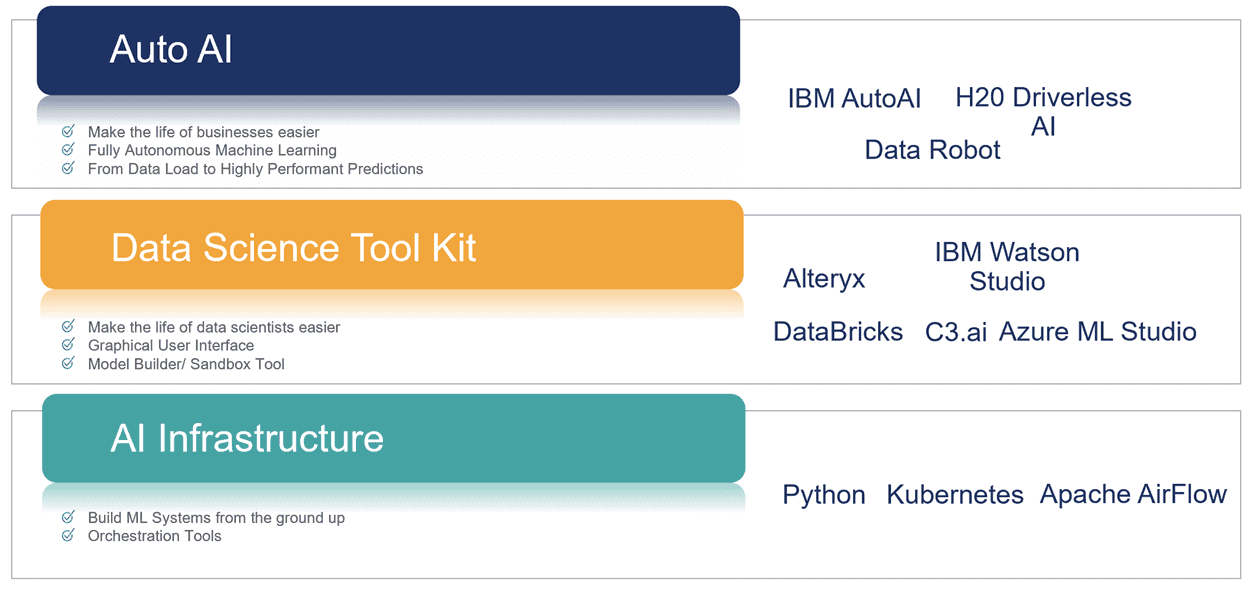
Corporate performance management vendors are also investing in AI capabilities to support extended planning & analysis (xP&A) processes such as demand planning and sales planning. As figure 5 illustrates well for AI vendors, CPM vendors will also solve the AI needs of their customers in different ways.
So what’s the lesson in all this?
Don’t let AI hype cloud the evaluation process. Start with a clear understanding of “what” business outcomes your FP&A team is trying to achieve with AI and ML. Identify “who” is using the solution and “how” the solution is unified into existing planning processes.
And with answers to these questions in mind, use the evaluation process to “get under the hood” to learn whether the solution will in fact unleash the organization from the key barriers that are holding FP&A back from moving beyond the hype.
Learn More
To learn more about how FP&A teams are moving beyond the AI hype, stay tuned for additional posts from our blog series or download our interactive e-book here.
Get Started With a Personal Demo



